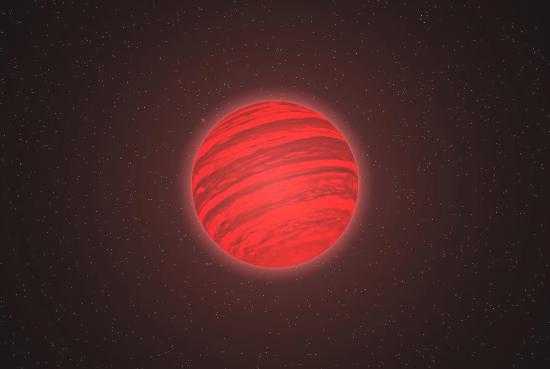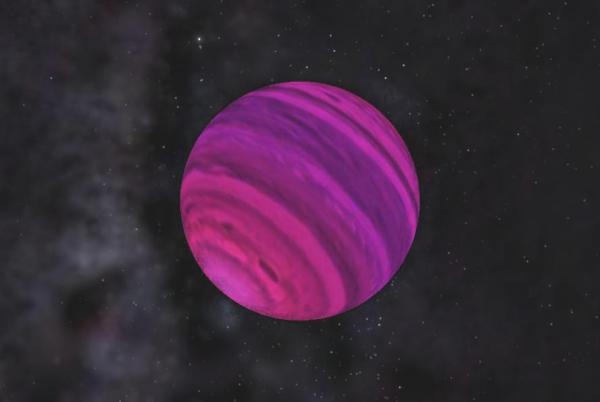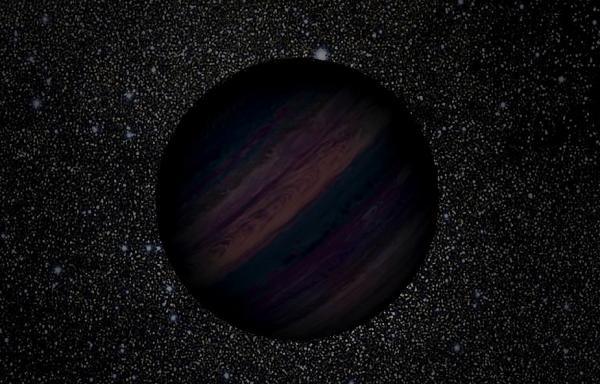BY LETTER
Brown Dwarf
 Image from Steve Bowers | |
| L type (lithium) brown dwarf | |
A massive object midway between gas giant and star; a starlike object too small to achieve nuclear reactions in its centre. Brown dwarfs usually form in the same way as stars do, but do not become large enough for hydrogen fusion to occur. Normal hydrogen thermonuclear fusion reactions will not ignite in the core of any stellar object smaller than about 0.08 Sol masses, although deuterium fusion will occur for a few million years or so in the larger brown dwarfs.
The dividing line between brown dwarfs and gas giant planets is about 13 times the mass of Jupiter. Unlike gas giants, brown dwarfs are massive enough to allow deuterium fusion in their core. This form of fusion can only occur for a certain period in the early lifetime of the star, but even after fusion ceases these objects are still hot because of gravitational contraction which converts gravitational energy to thermal energy. As they age, all brown dwarfs contract and cool, and will eventually become cold, dense objects similar in size and appearance to a large Jovian class world.
Because they are so dense, brown dwarfs have very high surface gravity, often in the region of 100 gees. For this reason they are not good sources of material for extraction. However many brown dwarfs have an accretion disc or a system of worldlets in orbit around them, and this material is readily available for use. The dwarfs themselves can be used as sources of power, in the form of heat or magnetic energy. Some dwarfs also exhibit flares, which can be hazardous, but also can be exploited given the right technology.
While some revolve around their primary like an ordinary planet, many more brown dwarfs exist in the depths of interstellar space. Some were ejected from a system by gravitational interactions with other stars while others formed on their own.
During the formation of stars from molecular clouds, a range of differently-sized objects may be formed; sometimes the smaller objects do not become large enough to become true stars as the winds from nearby proto-stellar objects blow away the gases and dust in their vicinity, causing them to be "starved" of material. Some of these sub-stellar objects become brown dwarfs; others become solitary planets.
In addition brown dwarfs can form within planetary systems both by gravitational collapse and by accretion, just like gas giants and smaller worlds.
 Image from Steve Bowers | |
| T type (methane) brown dwarf | |
Brown dwarfs are classified spectrally into L type, T type and Y type dwarfs.
L Type dwarfs (Lithium Dwarfs) are more massive, and are enriched in lithium as the process which removes that element from normal stars does not occur. L type dwarfs are dark red in colour.
T Type dwarfs (Methane Dwarfs) contain methane, as they are cool enough for that compound to persist. They are dimmer than L type dwarfs and are often a purplish magenta colour.
Y Type dwarfs (Ultra-cool brown dwarfs)are the smallest and coolest of the brown dwarfs, at a temperature of less than 500 Kelvin. These objects are not luminous in the visible spectrum and are visually very dark. They are detectable in the infra-red spectrum, but the smallest and coolest of these objects are very similar to solitary gas giants.
 Image from Steve Bowers | |
| Ultracool Y- Class Brown Dwarf, visually very similar to a Stevensonian class gas giant | |
Related Articles
Appears in Topics
Development Notes
Text by M. Alan Kazlev, amended by Steve Bowers
additional material by Selden Ball
Initially published on 08 October 2001.
additional material by Selden Ball
Initially published on 08 October 2001.






